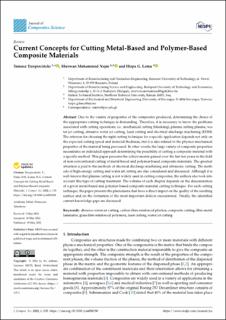| dc.contributor.author | Trzepieciński, Tomasz | |
| dc.contributor.author | Najm, Sherwan Mohammed | |
| dc.contributor.author | Lemu, Hirpa Gelgele | |
| dc.date.accessioned | 2023-03-22T09:12:46Z | |
| dc.date.available | 2023-03-22T09:12:46Z | |
| dc.date.created | 2022-09-01T14:46:06Z | |
| dc.date.issued | 2022 | |
| dc.identifier.citation | Trzepieciński, T., Najm, S. M., & Lemu, H. G. (2022). Current concepts for cutting metal-based and polymer-based composite materials. Journal of Composites Science, 6(5), 150. | en_US |
| dc.identifier.issn | 2504-477X | |
| dc.identifier.uri | https://hdl.handle.net/11250/3059706 | |
| dc.description.abstract | Due to the variety of properties of the composites produced, determining the choice of the appropriate cutting technique is demanding. Therefore, it is necessary to know the problems associated with cutting operations, i.e., mechanical cutting (blanking), plasma cutting plasma, water jet cutting, abrasive water jet cutting, laser cutting and electrical discharge machining (EDM). The criterion for choosing the right cutting technique for a specific application depends not only on the expected cutting speed and material thickness, but it is also related to the physico-mechanical properties of the material being processed. In other words, the large variety of composite properties necessitates an individual approach determining the possibility of cutting a composite material with a specific method. This paper presents the achievements gained over the last ten years in the field of non-conventional cutting of metal-based and polymer-based composite materials. The greatest attention is paid to the methods of electrical discharge machining and ultrasonic cutting. The methods of high-energy cutting and water jet cutting are also considered and discussed. Although it is well-known that plasma cutting is not widely used in cutting composites, the authors also took into account this type of cutting treatment. The volume of each chapter depends on the dissemination of a given metal-based and polymer-based composite material cutting technique. For each cutting technique, the paper presents the phenomena that have a direct impact on the quality of the resulting surface and on the formation of the most important defects encountered. Finally, the identified current knowledge gaps are discussed. | en_US |
| dc.language.iso | eng | en_US |
| dc.publisher | MDPI | en_US |
| dc.rights | Navngivelse 4.0 Internasjonal | * |
| dc.rights.uri | http://creativecommons.org/licenses/by/4.0/deed.no | * |
| dc.title | Current Concepts for Cutting Metal-Based and Polymer-Based Composite Materials | en_US |
| dc.type | Peer reviewed | en_US |
| dc.type | Journal article | en_US |
| dc.description.version | publishedVersion | en_US |
| dc.rights.holder | The authors | en_US |
| dc.subject.nsi | VDP::Teknologi: 500 | en_US |
| dc.source.volume | 6 | en_US |
| dc.source.journal | Journal of Composites Science | en_US |
| dc.source.issue | 5 | en_US |
| dc.identifier.doi | 10.3390/jcs6050150 | |
| dc.identifier.cristin | 2047952 | |
| cristin.ispublished | true | |
| cristin.fulltext | original | |
| cristin.qualitycode | 1 | |

